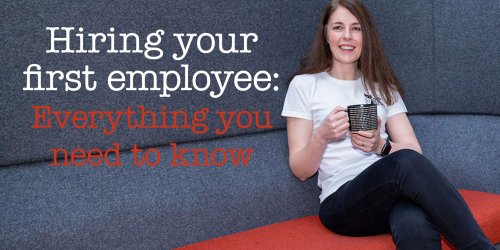Hiring your first employee?
Hiring your first employee is massive and you might be nervous about getting it wrong. Here I’ll take you through everything you need to know so that you can employ someone with confidence.
Step 1: Let’s talk about the cost of hiring your new employee vs not hiring.
Deciding to hire someone for the first time is a big decision and you’ve probably been thinking about all the benefits, disadvantages, and costs for a while now.
Can the business afford to pay someone else?
Will their value pay for their costs?
Could I just do all the work myself?
Will I be stuck if I don’t hire someone?
Only you can make this decision, with the help and support of your accountant and your HR mentor.
HR isn’t just about the legal stuff and firing people. As a HR mentor, I can help you successfully grow your business.
Here’s a bit of expert advice…
Before you hire your first employee, be really clear with what goals your business is trying to achieve and exactly how an employee is going to help you get there.
Write down EXACTLY what your new employee will be doing and how that specific action is going to help your business.
As an example, do you want to free up more of your time so you can focus on something else, for example keeping your customers and clients happy so that they stay with you for longer?
The things you decide here will help you create your job description and an advert for the job you want to recruit.
By doing this, you can hire with confidence knowing exactly how and when you’ll see a return from your investment.
If you need some help thinking this through, we’d be happy to help you create a People Plan.
Step 2: Next it’s time to find the right person for the job
Creating an awesome job advert will help you find the perfect person for the job. Here’s my advice…
Do your research to make the recruitment process as smooth as possible.
Here’s some things you should research:
Job title: What job title are people likely to be searching for? Use this as your job title too.
Pay: What are other employers paying for a job like this? Make sure you are competitive.
Benefits: Make sure you’re offering an attractive package, based on what people seeking work actually want.
Job sites: Where is your ideal new employee likely to be looking for a new job? Make sure that is where you are looking.
Here are some other things you need to think about:
Your employee branding: What is it about you, your company and the job that is great?
Key responsibilities: If you have done the background work already, you’ll have a detailed list of exactly what your new employee will be responsible for.
You can now create an attractive job advert. Here’s are things to include…
● An attention-grabbing headline and opening statement
● A bullet point summary of why your job is great
● A descriptive paragraph about the company, what your plans are and how this role / person is going to help you make a difference
● A summary of what skills and experience is required
● A bullet point summary of responsibilities
● Pay
● Other package and benefits
● Details on how to apply
Be careful! Important things to consider from a HR perspective
Although you may have a clear picture in your mind of who you want for the job, it’s important that your job advert doesn’t discriminate, otherwise you could land yourself in hot water.
If you get stuck, we can help you create an awesome job advert and handle the recruitment side of things too.
Step 3: Shortlisting and interviewing candidates
Hopefully you will have had many potential new employees who have applied and you now need to go through them and make a decision. Here’s my advice…
Reviewing applications
Wading through hundreds of CVs isn’t fun and it can be easy to start being inconsistent and disregarding people who may be a good fit.
So, before you start going through the CVs be clear on the skills and experience you’re looking for and create a criteria you can cross reference against to make things easier. Don’t be scared to add in a wild card though if you think they’d be a good fit.
It’s also important not to discriminate against people at this stage too.
Deciding what the interview process is going to look like
You need to think about what the interview process will look like to allow you to get to know your applicants better. How you do this will differ based on what the job role is.
You might decide for example to use a short 15 min screening telephone or Zoom call initially then shortlist for a longer face to face interview for example.
Decide how you’re going to record / track candidate progress
You may think you have a great memory. But after speaking to lots of different people, it will be difficult for you to be clear on who stands out. That’s why it’s important to decide how you’re going to keep notes about each candidate, if they match your criteria and at what stage of the interview process they are at.
Step 4: Offering the position to your chosen candidate….. and letting the others down
OK, so you have found the right person for the job and you’re really excited to get them started…
Here’s what to do next:
Firstly, jump on the phone with the successful candidate and verbally offer them the position and to make sure they’re still interested and want to accept.
If they are, fantastic! You can talk through the details of the offer and agree a start date. All of which should be confirmed in writing and sent to them as soon as possible.
Once you have sent this letter, it’s safe to then let the other candidates know that they haven’t been successful. You should do this offering feedback here possible.
Step 5: Now it’s time to get organised
Before your first new employee starts working with you, there are some tasks to complete:
● Check if they have the legal right to work in the UK. You may have to do other employment checks as well.
● Check if you need to apply for a DBS check (formerly known as a CRB check) if you work in a field that requires one (eg with vulnerable people or security.)
● Sort out insurance - you need employers’ liability insurance as soon as you become an employer.
● Register with HM Revenue and Customs (HMRC) as an employer - you can do this up to 4 weeks before you pay their first wage.
● Check if you need to automatically enrol your employee into a workplace pension scheme.
What HR documents will you need to prepare?
A contract of employment to be issued which includes:
● Your company name (the employer)
● Your new employees name (the employee)
●job title
●start date
● How much and how often they will get paid
● Hours and days of work and if/how they may vary.
● Holiday entitlement, and if that includes public holidays.
● Where they will be working and whether they might have to relocate
● If they will work in different places, where these will be and what the address is
● How long a job is expected to last (and what the end date is if it’s a fixed-term contract)
● How long any probation period is and what its conditions are
● Any other benefits being offered
● Obligatory training, and whether or not this is paid for by the employer
● pensions and pension schemes
● collective agreements
● any other right to non-compulsory training provided by the employer disciplinary and grievance procedures
It's also wise to create and provide an employee handbook which contains all your policies on things such as discrimination, mobile phone and internet use, as well as your expectations of your employee. You would also cover what they can expect from you as their employer, your legal obligations and their rights.
These documents are SO important because they are what protects you as an employer should anything go wrong. That’s why it pays to work with an HR to help you create them. This is something I can help you with.
Step 6: Your new employee’s first week. Start as you mean to go on…
It’s your new employees first day at work! They're not going to come in and jump straight in at the deep end - you'll need to do a bit of planning to make sure they get off to the best start.
Set up their desk. Have a computer ready, complete with their own login and e-mail account, and everything else they might need, such as logins for apps and software.
Create a plan for their first week, which should include them seeing how everything works, being trained on anything necessary to do their job and shadowing you while you demonstrate their duties.
Before any of this, make sure you give your new employee a tour of the premises, show them where everything is and explain what's around for lunch, where the facilities are etc too.
Make sure you cover everything they might need to know during their onboarding process, and always make time to address any concerns they may have and to answer their questions.
If their first day and week gets off to a good start, it's a great sign of things to come.
I hope this has made you feel ready to go out and find that first employee and start growing your business.
If you need some help with any of what I have covered I’m here to help. You can arrange a free 20 minute conversation with me HERE

